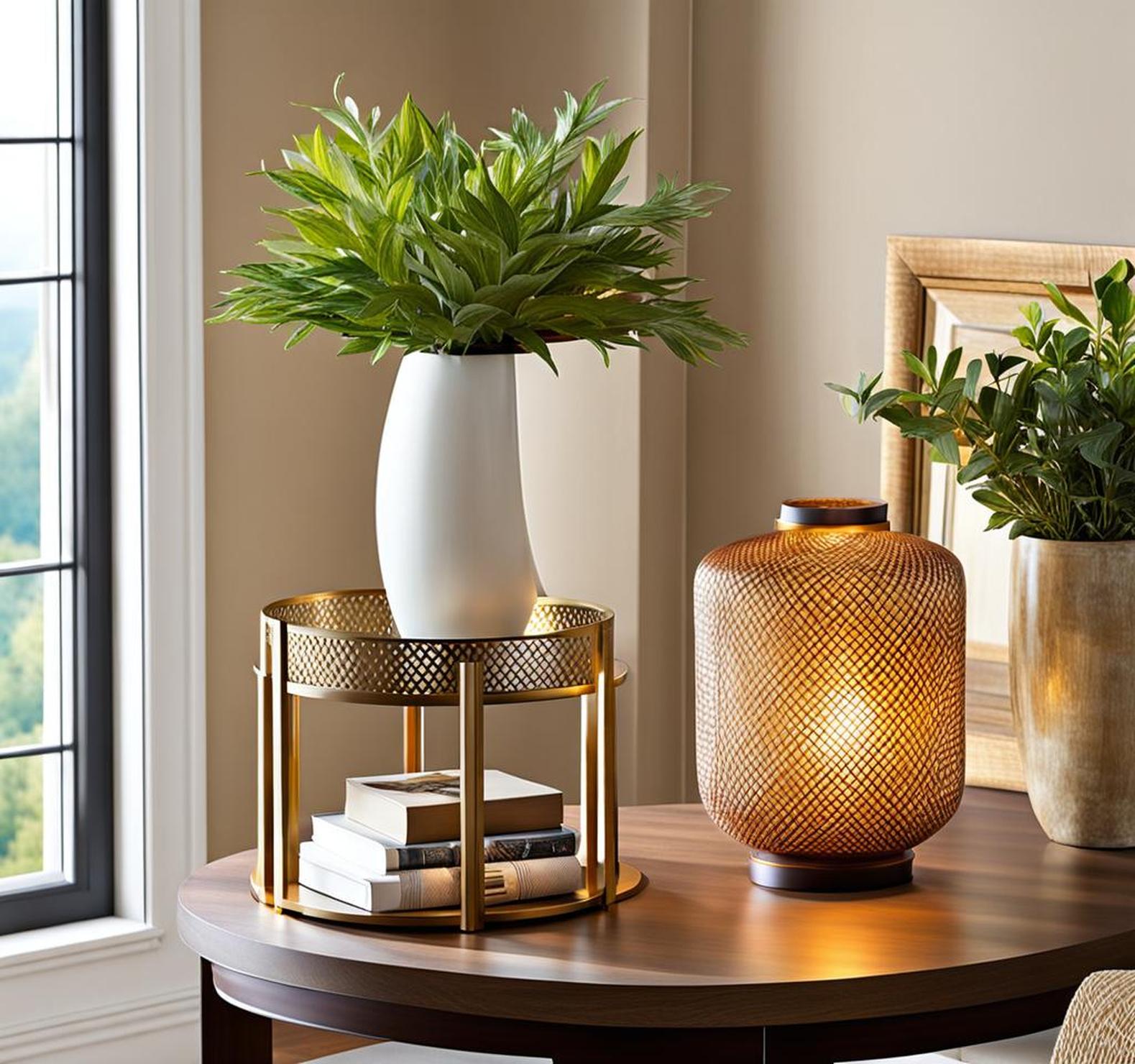Styling end tables is an easy way to elevate your living room design. With just a few decorative items, you can create an elegant vignette that enhances your space. The key is to keep it simple yet thoughtful. Follow these effortless tips for end table decor that looks put-together and polished.
First, take inventory of what you already own that could work for end table styling. Look at books, baskets, trays, vases, candles, and artwork that you can repurpose. Then, pick a style direction, like modern, traditional, or eclectic, to inform the rest of your choices. Determine what items need to be functional and easily accessible too. With some planning, you’ll be ready to curate your elegant end table decor.
Keep it Simple Yet Impactful
When styling your end table, avoid clutter by limiting yourself to just 3-5 decorative items. With fewer pieces, each one can stand out. Choose one special focal point, like a statement vase, sculptural bookstack or potted plant. Supplement it with a couple smaller-scale accents. Allow negative space around and between items for a clean, elegant look.
Limit Items to 3-5 Per Table
Placing too many items on an end table risks looking disorganized and distracting. Stick to 3-5 complementary decorative pieces for the most appealing symmetry and visual weight.

This “styling by numbers” approach allows each element to shine. Any more and the vignette starts competing with itself. Keep it simple for elegance.
Choose One Focal Point
Every end table vignette benefits from one star player that immediately catches the eye. This can be a dramatic lamp, sculptural vase, elegant plant, or stacked set of coffee table books. Choose a focal point with presence that anchors the arrangement.
Surround your focal point with 2-4 supporting decorative objects. Their role is to supplement the lead player, not compete with it. Unity, not chaos, is the goal.
Embrace Negative Space
Allow breathing room between the objects on your end table. Negative space helps turn a pile of items into a purposeful vignette. Space gives the eye a place to rest and keeps your arrangement looking airy and open.
Start by placing decorative items near the back edge, centered on the table. Leave 3-5 inches between objects and around their perimeter. This creates elegance through simplicity.
Add Height and Layers
Incorporating different heights and layers to your end table adds visual interest and dimension. Stacking books creates attractive platforms to raise key items. Overlapping objects provides depth. Containers like baskets neatly corral smaller accents.
Use Books as Risers
An easy technique is using stacks of coffee table books or novels to add vertical levels. Arrange them into a staircase shape or into one tall tower. Then place decor items like vases, trays, or candles on top to raise them up.
The varying heights add depth and make the tablescape more dynamic. The book colors and textures also complement other materials.
Overlap Items
Slightly overlapping decorative objects tricks the eye into seeing more depth. It creates a layered, collected look with more dimension. Try placing a shorter item, like a plant, partially in front of a taller one, like a vase or lamp.
Make sure the shorter item doesn’t fully obscure the taller one behind it. The subtle peekaboo effect makes the vignette more interesting to examine up close.
Incorporate Natural Elements
Bringing nature indoors through plants, flowers, and organic materials makes end table vignettes feel livelier and fresher. A touch of green or a pop of color enlivens the whole display.
Fresh Flowers and Foliage
Nothing beats fresh florals for brightening up an end table instantly. Choose blooms in a favorite hue or ones matching your decor. For easy elegance, opt for a single stem or small bouquet displayed in a slender vase or bottle.
Consider mixing in greenery, like eucalyptus or ferns, for added texture and verdance. Cuttings from an outdoor garden work too.
Potted Plants or Succulents
Houseplants are an easy way to bring life and nature to your end table display. Opt for low maintenance varieties like succulents, snake plant, or pothos. Their sculptural shapes and textures complement other decor.
Choose a plant size proportional to your end table’s footprint. Place it near the back and use it as your focal point or layered accent.
Wood, Rattan, or Wicker Accents
Natural woven textures like rattan, wood, or wicker make warm, organic accents. Incorporate a decorative bowl, tray, or basket on your end table. The contrast of these materials with stone, metal, or ceramic pieces adds compelling visual interest.
A simple wooden tray can also neatly corral smaller items, keeping your look curated and tidy.
Finishing Touches
Final styling tricks help pull your end table arrangement together into one cohesive, polished-looking vignette. Little tweaks go a long way.
Style in Odd Numbers
Curating your items in odd numbered groupings is more pleasing to the eye than even pairings. Arrange items in set of 3, 5 or 7 for best results.
Our eyes prefer asymmetry. Odd numbers also convey an informal, collected sensibility.
Tweak for Symmetry
Take a step back and examine your end table from afar. Make micro adjustments so items feel visually balanced. Ensure your focal point is properly centered.
Precise item placement creates a sophisticated symmetry. Move things just a hair until the aesthetic clicks.
Look for opportunities to repeat or echo colors already in the space. For example, pick up a blue or green tone from artwork or pillows. This creates a cohesive, polished look.
Your end table is an extension of the living room’s overall color palette. Let it enhance the harmonious flow rather than compete.
The end table can be styled with a mix of decorative objects, different heights and layers, natural elements and thoughtful finishing touches. Elevate any space with these easy yet elegant decorating ideas that require minimal effort but yield impressive results.
